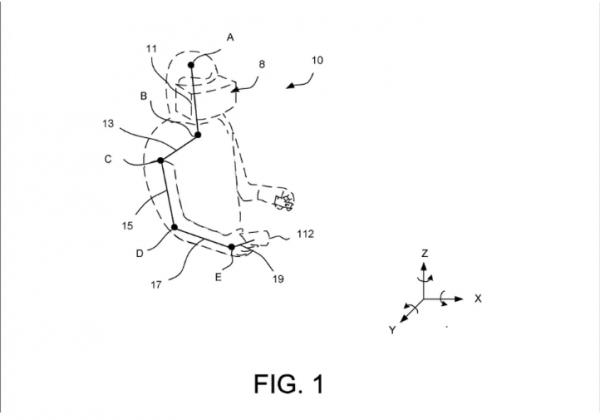Google Invents VR Controller That Adds Location and Orientation Tracking
A patent filing published this Thursday describes Google’s plan to invent a “VR Arm Model” that could make it possible for systems to supplement tracking information for the location of the controller in both space and orientation in which the user is holding it.
The patent is exploring ways through which virtual reality systems could gain more understanding of the location or position of their hands. The system will estimate skeletal movements relative to the user’s head by using the rules of skeletal movement. It basically applies Inverse Kinematics in its estimations to create consistent-looking or natural movements by relying on the rules of the “skeletal” system. The system will “know” the position of the user’s head and where it’s facing from the sensors that will be built into the head-mounted device. When the wearer moves their head, a series of natural axial movements obviously ensue. Naturally, the movement of the head moves the shoulder joint which subsequently moves the elbow which in turn moves the wrist and then the hand in a standard format along every axis of the arm. This is the rules of the skeletal system that system will master to bring about new freedom VR controllers.

The past few months has seen a strong move towards Mixed Reality and virtual reality headsets. There is the PC-based Oculus Rift S that is hitting the market by spring this year and Microsoft recently launched the HoloLens 2. Other leading players such as Samsung, Google and Apple have also filed a host of patents for head-mounted devices many of which are expected to go into production and release in a few years’ time. The latest Google patent is in tune with recent big moves by other tech players that have projects in the pipeline in the AR, VR or MR space.
Google is also planning to roll out a high-end streaming game platform that it calls Stadia later in 2019 so every patent that it files in this space acquires a greater significance as it could be tied together with its larger platform development efforts.
The latest Google patent for the VR Arm Model describes a new programming method that will create a new type of freedom for the virtual reality controllers which goes beyond the traditional three degrees of freedom (3DoF) currently in use with most VR systems. This invention will allow users to get an even more realistic gameplay in their virtual reality experience.
Many virtual reality systems in use involve the wearer interacting with the virtual objects inside a virtual environment using the head-mounted display (HMD) and a hand-held controller. However, such systems are not faultless. Limitations occur with hand-held controllers with purely three degrees of freedom (3DOF) tracking based on yaw, pitch and roll.
For example, using a head-mounted device, a user can visualize the virtual reality environment by turning and tilting their heads in various ways. The limited capabilities of 3DoF will in turn have an impact on the efficiency within which you can track with a virtual controller, within the view of the head-mounted device. A physical controller will not track an absolute location in spaces so the 3DoF will be handicapped when it comes to applications such as locational tracking.
Google’s Controller Based on VR ARM Model
Google’s invention of a controller that’s based on the VR ARM Model will address the limitations of 3DoF by leveraging on orientational tracking of the HMD’s physical controller thereby creating an orientation and location of the virtual controller which is viewable within the HMD. In the patent filing, Google describes an implementation of the VR Arm Model where simulating someone holding the controller at a particular location and orientation will be possible in the virtual reality environment.
The virtual controller could also be in a virtual reality environment at a location corresponding to the way in which the user holds and moves the physical controller.
The invention seeks to improve the ways of tracking hand-held physical controllers in a virtual reality system. These can involve the definition of a segment in the arm between the elbow joint and the wrist joint.
https://virtualrealitytimes.com/2019/03/23/google-invents-vr-controller-that-adds-location-and-orientation-tracking/https://virtualrealitytimes.com/wp-content/uploads/2019/03/Google-Stadia-600x400.jpghttps://virtualrealitytimes.com/wp-content/uploads/2019/03/Google-Stadia-150x90.jpgInventionsA patent filing published this Thursday describes Google’s plan to invent a “VR Arm Model” that could make it possible for systems to supplement tracking information for the location of the controller in both space and orientation in which the user is holding it. The patent is exploring ways through...Sam OchanjiSam Ochanji[email protected]SubscriberVirtual Reality Times - Metaverse & VR

